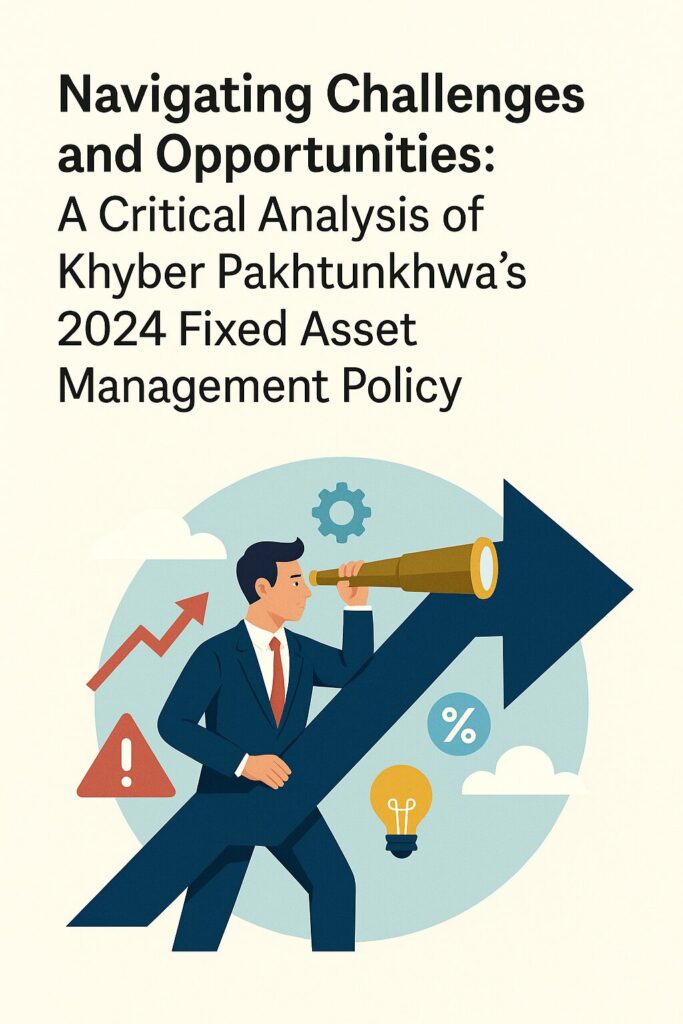
The Khyber Pakhtunkhwa (KP) government’s 2024 Fixed Asset Management (FAM) Policy marks a significant step toward modernizing public resource management. Targeting the Health and Elementary & Secondary Education (E&SED) departments, the policy aims to address systemic inefficiencies in managing assets like infrastructure, equipment, and technology. While the document outlines an ambitious framework for transparency and accountability, its success hinges on addressing implementation challenges and leveraging emerging opportunities. This article critically examines the policy’s strengths, gaps, and transformative potential.
Key Features of the Policy:
The FAM Policy 2024 is structured around three pillars:
1. Governance Arrangements: Establishes a Central Asset Management Unit (CAMU) under the Planning & Development Department (P&DD) to oversee asset lifecycle management, supported by sectoral committees at provincial and district levels.
2. Asset Management Information System (AMIS): A centralized digital platform for real-time tracking, integrating financial data with asset registers to enable data-driven decisions.
3. Competency Strengthening: Focuses on training programs, capacity building, and aligning practices with international standards like IPSAS and ISO 55000.
The policy emphasizes compliance with laws, risk management, and regular evaluations. Key actions include standardized asset classification, lifecycle budgeting, and protocols for maintenance, disposal, and transfers. Annexures provide detailed guidelines for implementation, risk assessments, and roles, reflecting a comprehensive approach.
Strengths and Innovations:
1. Holistic Framework: The policy’s three-pillar structure addresses governance, technology, and human capital, creating a cohesive strategy. CAMU’s oversight ensures accountability, while AMIS promises transparency through digitized asset tracking.
2. Alignment with Global Standards: By adopting IPSAS for accounting and ISO benchmarks for asset management, the policy enhances credibility and facilitates future audits or collaborations.
3. Decentralized Implementation: District Education Officers (DEOs) and Health Officers are empowered to manage assets locally, aligning investments with community needs. This devolution could improve responsiveness.
4. Focus on Sustainability: The policy mandates environmentally responsible disposal practices and encourages recycling, reflecting a commitment to sustainable development.
Critical Challenges and Gaps:
1. Implementation Hurdles: While the policy outlines timelines (e.g., AMIS rollout by FY 2024/25), it lacks specifics on funding allocation and resource mobilization. Without budgetary clarity, procurement delays and under-resourced training programs could derail progress.
2. Technological Barriers: AMIS’s success depends on robust IT infrastructure and digital literacy, particularly in rural areas. The policy does not address connectivity gaps or cybersecurity risks, which could compromise data integrity.
3. Stakeholder Engagement: Frontline workers, such as school principals and health facility managers, are critical to maintaining asset registers. However, the policy assumes compliance without detailing incentives or accountability mechanisms for these stakeholders.
4. Risk of Bureaucratic Inertia: The multi-layered governance structure—CAMU, sectoral committees, and district nodes—may lead to coordination challenges. Overlapping responsibilities could slow decision-making.
Opportunities for Transformation:
1. Data-Driven Governance: AMIS can enable predictive maintenance, optimize budgets, and reduce waste. For instance, linking asset utilization data with student enrollment or patient outcomes could improve resource allocation in schools and hospitals.
2. Public-Private Partnerships (PPPs): The policy encourages PPPs for infrastructure financing. Collaborations with tech firms could accelerate AMIS development, while partnerships with maintenance providers might reduce operational costs.
3. Community Involvement: Engaging local communities in monitoring asset conditions (e.g., school furniture, medical equipment) could enhance accountability and foster public trust.
4. Scalability: Successful implementation in Health and E&SED could serve as a model for other sectors, such as transportation or agriculture, amplifying the policy’s impact.
Recommendations:
To maximize the policy’s potential, the KP government should:
– Allocate Dedicated Funding: Ensure budgets for AMIS deployment, staff training, and periodic audits. Explore grants or donor partnerships to supplement provincial resources.
– Strengthen Local Capacity: Conduct hands-on workshops for district officers and facility managers, emphasizing AMIS usage and maintenance protocols.
– Leverage Pilot Projects: Test AMIS in high-performing districts before province-wide rollout, using feedback to refine processes.
– Enhance Monitoring: Establish independent audit teams to evaluate compliance and publish annual progress reports for public scrutiny.
The KP FAM Policy 2024 is a visionary document with the potential to transform public asset management. Its emphasis on transparency, technology, and training aligns with global best practices. However, bridging the gap between policy design and ground-level execution will require addressing funding gaps, technological barriers, and bureaucratic inertia. By fostering collaboration, investing in capacity building, and prioritizing stakeholder engagement, KP can turn its ambitious framework into a replicable model for efficient governance. The policy’s success will ultimately depend on the government’s ability to navigate these challenges while seizing emerging opportunities.
